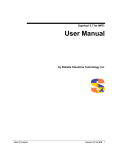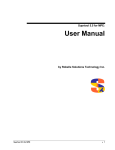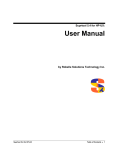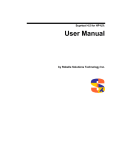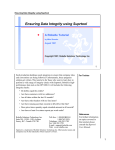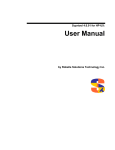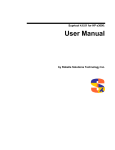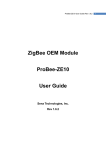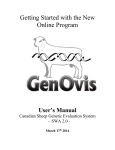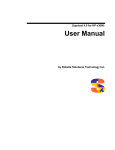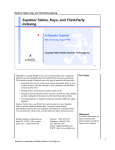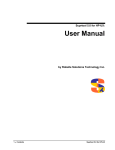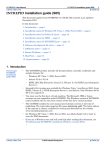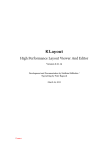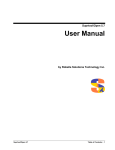Download Suprtool Quick Reference Guide (419K )
Transcript
SUPRTOOL™ 5.7 Database Handyman for HP e3000 and HP-UX and Linux Quick Reference Guide Suprtool Commands by Function In/Out Add Base Chain Get Input Numrecs Open Output Select Process Clean Delete Extract Key List Put Sort Total Update Dbedit Suprlink Add Change Delete File List Modify Q Input Join Link Output Reset Xeq Select Define Duplicate If Item Table Control Edit Export Link Q Reset Userpause Xeq =calc :o/s cmd STExport Columns Clean Date Decimal Delimeter Escape Floating Heading HTML Input Output Quote Reset Sign Spaces Xeq Xml Zero Commands Common to All Modules Before Do Exit Form Help Listredo Redo Set Use Verify Robelle Solutions Technology Inc. Suite 372, 7360 137 Street Surrey, BC Canada V3W 1A3 Phone: (604) 501-2001 Support: (289) 480-1060 E-mail: [email protected] Web: www.robelle.com Copyright 1985-2015 Robelle Solutions Technology Inc. Suprtool Commands The following list describes the commands that Suprtool understands at the ">" prompt. Continue command lines with "&" and combine commands on one line with ";". Shorten command names to the substring printed in capitals (e.g., BA for Base). You can use CI !variables in commands on MPE and $environment variables on HP-UX. Add tablename Add ownername.tablename The Add command inserts records into an Oracle table. Before records can be added, an Oracle database must be open. You can specify just the tablename or the ownername.tablename combination. The specified table name must be a valid table, not a view. For adding records to an Eloquence database please see the Put command. >add customer BAse [[host][:service]/]database Open an Eloquence database (close current base). Base command also follows value of Eloquence variable EQ_DBSERVER. base sample,5 base :eloqdb/sample,5 base hostname.robelle.com:eloqdb/sample,5 BAse [system#] base [ mode ] [ pass ] Open an IMAGE database (close current base). Specify remote base with system# prefix. Use "?" for pass to prompt with no echo in batch. (Default: logon = system, mode = 1, pass = ";") >base actrec.dat {mode = 1, pass = ";"} >base actrec.dat,5,reader >base sys2#act.db,5 {remote on sys2} Before [ start [ /stop ]] | string | [ ALL | @ ] Redo commands with chance to modify. (Default: previous) Clean [ SPECIAL | <string> <range> ] Specifies what characters to clean when using the $Clean function. The SPECIAL keyword means characters from Decimal 0 to Decimal 31. Characters that match those defined with the Clean command, will be replaced by the value defined by Set CleanChar, which defaults to space. Clean characters can be defined with decimal notation "^" and/or the actual character as a string. To find records with specific characters see the $findclean function in the IF command. >in mysdfile >clean special,"^128:^190","^255","}" >extract byte-field = $clean(byte-field) Chain setname search-field = [ key-values | table ] Read an IMAGE or Eloquence dataset by search path, TPI, or B-tree and select specific records (masters) or chains of records (details) for explicit key values; requires previous Base command. Specify the key values either 2 Legend: MPE version only HP-UX version only by an explicit list of values separated by commas or by a table name (see Table command on page 9.) >chain >table >chain >chain d-sales,customer="12345" slist,customer,file,slist.db d-sales,customer=slist d-sales,part-no="3YJ " Define field byteposition sublen [ type ][ subcount ] Define a new data field (name <33 characters) by specifying an absolute location and format. First byte of input record is 1. See Data-Types on page 12. (Default: type = byte, subcount = 1) >define city,11,10 {byte type} >define TransType,1,2,int {1 = first} >def amt,11,2,int,12 {amt repeats 12 times} Define field fieldname [ qualifier ] Define a new data field that is relative to the position of an existing database or Defined field. The qualifier equals [(subscript)] [ [offset] ] [sublen] [type] [subcount] The (subscript) specifies one sub-item of a compound item such as 5J2; 1 is the first and default sub-item. The offset specifies a byte offset from the existing location of fieldname; 1 is the default. The sublen and type override the existing size and data-type. See Data-Types on page 12. When you specify a subcount, the sublen is the byte-length of each subfield. >define itemcount,status,2,int >define costtotal,status[2],4,ieee >define middle,name(2) DELete Delete selected records from IMAGE or Eloquence input dataset using DBDELETE. DO [ start [ /stop ]] | string | [ ALL | @ ] Repeat previous commands without modifying them. >do 5/9 >do if {repeat several commands} {repeat last If command} DUplicate ONLY | NONE KEYS [num] | RECORD [ COUNT ] [ TOTAL field ... ] Include or exclude duplicate records for the output file. There are options to count the duplicate output records, and to total up to fifteen fields. >duplicate >duplicate >duplicate >duplicate >duplicate none only none none none keys {remove dups} keys {keep only dups} keys 1 {first sort level} keys count {count dups} keys total sales-amt, units-sold EDit Edit a database (see Dbedit Subsystem on page 18). Use the Base command before using the Edit command. 3 Legend: MPE version only HP-UX version only Exit [ ABORT | SUSPEND | XEQ ] Perform task and return to parent process. Exit Abort abandons task. Suspend lets you return to task later. >exit >exit suspend {default = Xeq} {stop without executing} EXPort [ stexport-command ] Invoke STExport/MPE as a son process or pass a command to STExport. >export input sdfile You cannot use Suprtool/UX's Export command to invoke STExport/UX, but you can run STExport/UX by itself. >/opt/robelle/bin/stexport EXTract field [ (subscript)] [ = value | = field2 | = expression ] [ ,.. ] Create output records by stringing together fields from the input record and constant values. Extracts are cumulative; you can use multiple extract commands. Extract can use dates (see Item command on page 6) and expressions (one per command, must be at the end of the command). >ext >ext >ext >ext >ext >ext >ext >ext >ext >ext >ext >ext >ext >ext >ext >ext >ext >ext >ext >ext >ext >ext >ext >ext >ext >ext >ext >ext >ext >ext >ext >ext custnum,transtable(3) CustTotal=15000 CustName," ",CustAddr SalePrice = (SalePrice * 1.10) Day = (date-field mod 100) ByteField = ^7 {= ^G (bell)} c = (6000 - cost) yesterdate = $today(-1) date-field = $date(*/*/*-1) ccyymmdd-i2 = $stddate(date-mmddyy) date-field = $stddate($days(date-field) +7) num-days = ($days(date1) - $days(date2)) positive = $abs(num-expression) packed-field = $signed(integer-field) int-field = $truncate(real-expression) full-name = ($trim(first-name) + " " + & $trim(last-name)) lowercase = $lower(city) uppercase = $upper(city) $ETOA(ByteField) {EBCDIC to ASCII} field = $lookup(table,key,tabledata) new-price=$number(new-price-ascii) dbl-count=$counter count=$subcount(order-number) first-name=$split(full-name,first,"/") address(1)=$clean(address(1)) mytotal=$total(sales-dollars) mysub=$subtotal(sales-dollars,order-number) int-field=$number(byte-number) edit-amount=$edit(sales-amount,"$$,$$$.99-") mycbcount=$subcount(sort-break) full-name=$proper(full-name) name=$translate(name) EXTract field1 [ (subscript1) ] \ field2 [ (subscript2) ] Specify an inclusive range of fields to extract. >ext ProductNo \ SalesQty >ext SalesAmt(4) \ SalesAmt(6) 4 Legend: MPE version only HP-UX version only Form [ SETS | ITEMS | PATHS | dataset | data-item | filename ] Show information about IMAGE or Eloquence database, datasets, items, or self-describing files. On HP-UX output goes to $stdlist. On MPE output goes to Formout file, defaulting to $stdlist. {list the datasets} {details on d-cust set} {fields in self-describing file} >form sets >form d-cust >form sdfile Get setname [ subset ] Select an IMAGE or Eloquence dataset as input source; requires previous Base command. Subset options select only part of dataset. (Default: read the entire dataset.) [ (startrec/endrec) ] {range of record numbers} [ (#n) ] {selects every nth record} >get dtrans >get dtrans(100/200) >get dtrans(#4) {first record is 1} {every 4th record} Help [ command-name | keyword [ ,section ]] Provide access to the on-line user manual. Type a keyword (e.g., Help Access) or a command-name. HQ for brief help. >help >hq list {default is browse} {quick summary of List command} IF expression Select a logical subset of the input source through an expression that tests one or more fields. See Record Selection on page 13 for details. >if >if >if >if >if >if >if >if >if >if >if >if >if >if >if >if >if >if >if >if TransCode="01" and amount>1000 $upper(City)="VANC","SEAT","PORT" StatWord.(4:1)=1 and addr=="@BC@" a = alpha $lookup(part-no-table,partno) date=$today TotalPrice <> (SalesTotal + Taxes) $null(salestotal) not $null(salestotal) $invalid(date-field) $stddate(dt-mmyydd) < $stddate(dt-aammdd) (date-field mod 100) = 01 InDate <= $date(*/*-6/*) {6 months ago} ($days(ship-date) - $days(order-date)) > 14 $abs(oldprice - newprice) > 10 $truncate(total / months) > 10 $lower(city) = "niagara falls" $ltrim(last-name) = "Armstrong" $findclean(last-name) $lookup(mytable,char-field,id-field)=id-field Input file [ = dataset ] [ subset ] Select an MPE or KSAM file as input source. The file can be the name of an existing disc file or a reference to a :File equation (*name). The =set option requires an open base because the file is assigned the same record format as the IMAGE set. The first record is 0, except for some KSAM files where it is 1. Subset options select only part of the file. [ (startrec/endrec) ] {range of record numbers} 5 Legend: MPE version only HP-UX version only [ (#n) ] {selects every nth record} >input log23 >input * >input trans(#5) {disc file} {$stdinx} {every 5th record} Input file [ fileinfo ] [ subset ] The file is the name of an HP-UX file. The fileinfo options are Reclen, LF, and NOLF. The Reclen option must be followed by the record length (in bytes) of each data record. Subset options select only part of the file. [ (startrec/endrec) ] {range of record numbers} [ (#n) ] {selects every nth record} >input uxfile,reclen 80,nolf >input sdfile {requires ".sd" file} ITem itemname DATE | DECIMAL attribute Define the date format or implied decimal places for an item. For compound items, all sub-items are assigned the same date type or number of decimal places. The attribute is a string for Date and the number of decimal places for Decimal. The Date attributes describe the format of the date. yymmdd ddmmyy mmddyy yyyymmdd ddmmyyyy mmddyyyy ASK PHdate calendar yymm yyymmdd Oracle ccyymmdd ccyymm yyyymm aamm aammdd mmddaa ddmmaa ccyy SRNChronos mmyyyy yyddd ccyyddd HPCalendar EDSDate JulianDay PHdate8 X6 Z6 J2 K2 P8 X6 Z6 J2 K2 P8 X6 Z6 J2 K2 P8 X8 Z8 J2 K2 P10 X8 Z8 J2 K2 P10 X8 Z8 J2 K2 P10 J1 J1 K1 J2 K2 J1 K1 X4 Z4 J1 K1 J2 P8 X7 X8 Z8 J2 K2 P10 X6 Z6 J2 K2 P8 X6 Z6 J2 K2 P8 X4 X6 X6 X6 X4 Z4 J1 K1 X6 X6 Z6 J2 K2 P8 X5 Z5 J2 K2 P8 X7 Z7 J2 K2 P10 J2 K2 J2 P8 J2 J1 K1 J2 K2 >item UnitCost,decimal,2 >item InDate,date,ddmmyy >extract InDate=$today(-1) {yesterday} >if InDate<=$date(*/*-6/*) {6 months ago} 6 Legend: MPE version only HP-UX version only [ Key ] byteposition bytelen [ type ] [ DESC ] Define an arbitrary sort field anywhere within the input record. See DataTypes on page 12. (Default: type = byte, ascending) >key 1,10 >key 21,4,double >key 25,2,int,desc >25,2,int,desc {first ten bytes} {double integer} {descending order} {omitted the Key command name} LINk [ suprlink-command ] Invoke Suprlink as a son process or pass a command to Suprlink . >link input sdfile You cannot use Suprtool/UX's Link command to invoke Suprlink/UX, but you can run Suprlink/UX by itself. /opt/robelle/bin/suprlink List [ STANDARD ] [ RECORD ] [ DUPLEX ] [ TITLE "string" [ DATE format ] ] [ HEADING "string" [ "string"... ] ] [ ONEPERLINE ] [ LABEL ] [ PCL format ] [ NOREC ] [ NONAME ] [ NOSKIP ] [ OCTAL | HEX | DECIMAL ] [ CHAR ] [ LEFTJUSTNUM ] [ RIGHTJUSTNUM ] [ TIME format ] [FILE name APPEND RECLEN size] [ LP ] [ DEVICE name ] Report selected records to Suprlist file, defaulting to $stdlist. Report selected records to $stdlist to an LP device or to a file using the FILE option and control the size with the RECLEN option. Standard produces a columnar report, but the default is either a formatted listing or Octal/Char if the file is unstructured. Use Title and Heading to customize the listing. Record prints on attached printer, and Duplex prints two sided. >list standard record {to attached printer} >list stand title "Overdue Accounts" LISTREDO [ start[ /stop ] | [ ALL | @ ] string ] [ ;ABS | ;REL | ;UNN ] [ ;OUT file ] Display previous commands; ",," is shortcut. (Default: last 20 commands) >listredo 10/40 >listredo input {all Input commands} 7 Legend: MPE version only HP-UX version only Numrecs number | percentage% Specify size of input, output and Sortscr files as an absolute number of entries or as a percent of input size. Required for input tape files. >numrecs 100000 >numrecs 5% {5% of the input} OPen ALLBASE dbename owner ORACLE username password Open an SQL database. Allbase is supported on MPE and HP-UX. Oracle is supported on HP-UX only. >open allbase inventory anne >open oracle scott tiger >open oracle scott/tiger@machine Output file [ format ] [ APPEND | ERASE | TEMP ] Define the name of the output file as one of the following: a new disc file (default), an existing disc or KSAM file (Append or Erase option), "*" for $stdlist, a reference to a :File equation (*name), or =Input to sort a file into itself. If you use List, Put, or Total, output defaults to $null. Output produces the same record format as the input source (adjusted by Extract commands), unless you override with format keywords: DATA ELSE KEY PRN QUERY LINK ASCII DISPLAY NUM NUM,KEY NUM,DATA NUM,QUERY NOLF LF default Records not qualified by if condition sort keys only PC file format self-describing better self-describing format convert from numeric convert to display J2 input record number only J2 input record number & sort keys J2 input record number & data record "numbers" format Do not write out line feeds to end of record Write out line feeds to end of record Converted ASCII fields have a trailing sign (usually blank for positive values). Size depends on the binary field's format: E2 R2 I1 J1 I3 J3 K1 Zn 12 bytes 06 bytes 16 bytes 05 bytes n+1 bytes >output >output >output >output >output >output >output >output >output E4 R4 I2 J2 I4 J4 K2 Pn 23 bytes 11 bytes 20 bytes 10 bytes n bytes newfile newfile,temp *,ascii =input cleanfl,erase ksamfl,erase trans1,append sdfile,link lotus,prn {build newfile} {build temp file} {$stdlist display} {sort into itself} {existing file} {load KSAM file} {append to file} {self-describing} {ready to download} Put set [,[host][:service]/]database] Put the output records to an Eloquence dataset by using DBPUT. 8 Legend: MPE version only HP-UX version only Put Put Put put trans dtrans,sample,5 dataset,:eloqdb/sample,5 dataset,hostname.robelle.com:eloqdb/sample,5 Put set [ ,base [ ,mode [ ,password ] ] ] Put the output records to an IMAGE dataset by using DBPUT. >put dtrans,actrec,4 {another base} >get curmonth;put history {same base} Q [ "string" ] Print a string on the CRT. (Default: print blank line) >q "Sorting customer records" {quoted} REDO [ start[ /stop ]] | string | [ ALL | @ ] Redo command lines; modify using MPE control codes. {repeat previous Input command} >redo input Reset [[ ALL | @ ] | command [ ... ]] Reset aspects of the current task. Reset All resets all input and output commands, but not Define and Set options. (Default: Reset Delete, Sort, Key, If, List) >reset if >reset all {reset If command} SELect statement Specify an input source with an SQL select statement. Some processing options can be specified on the Select statement or with other Suprtool commands. Using SQL to sort: >select * from user.acct@emp order by name Using Suprtool to sort: >select * from user.acct@emp >sort name Set option-name value Enable/disable options. See Configuration Options on page 14. Verify Set shows current values. >set statistics off SOrt field [ (subscript) ] [ DESCending] Specify a field or a Defined field as a sort field. For compound items, the first sub-item is the default. >sort CustNumber {default ascending sort} >sort total desc {descending order} >sort StreetAddress(2) TAble tablename itemname keyword qualifier Build a table of values for testing in the If and Chain commands, or for extracting from the table with the Extract command. The tablename (up to 16 characters) must be unique. Itemname is a database item or a Defined 9 Legend: MPE version only HP-UX version only field, or a field in a self-describing file. For compound items, Table uses the first sub-item. The keyword is one of ITEM, FILE, or SORTED. The format of qualifier depends on keyword: for ITEM, a list of explicit data values; for FILE and SORTED, a filename whose data is unsorted or sorted by itemname, followed by an optional HOLD keyword and an optional Data keyword indicating a list of data fields to be loaded from the self-describing file. Keyword ITEM FILE or SORTED Qualifier value [ value ... ] filename [ HOLD ] [ DATA (fieldlist) ] >table select,ccode,item,"ABCD","FILM" >chain m-customer,ccode=select >table select,ccode,file,extract.file,hold >if $lookup(select,ccode) >table t,ccode,file,sdfile,data(updatefield) >update >extract dbfield=$lookup(t,ccode,updatefield) >table t,ccode,file,sdfile,data(updatefield) >if dbfield=$lookup(t,ccode,updatefield) Total field [ (subscript) ] [ decplaces ] $FILE file [ APPEND | ERASE | TEMP ] $FILE $LIST Compute sum total of a numeric field value in all selected records and print the result with a specified number of decplaces (default is 0 unless specified in Item command). The $file option prints the totals to a file or to the List device ($list). (Default: subscript = 1) >total cust-balance,2 >total $file tothist,append UPdate [ CIUPDATE ] Update IMAGE or Eloquence fields specified by subsequent Extract commands. >update >extract status-code="OLD" Use[Q] filename Execute commands from a Text file or a Qedit file. >use define6.usefile USERpause "string" Print prompt string; wait for any key. >userpause "Press Return" Verify [ ALL | @ | VERSION | command [ ... ] ] Show current specifications. >verify input {print name of input file} Xeq Perform the specified task, then wait for more commands. 10 Legend: MPE version only HP-UX version only More Suprtool Functions O/S commands >purge abc >run myprog >!rm abc >!chmod 777 myfile Calculations {try "=?" for help} >=312/4 Sort keys >10,2,integer Comments >{this is a comment in braces} Modify Functions In The Before Command Printing characters replace; control keys edit. Move with the spacebar. Press the Return key after each function. ^ means Control. ^A ^B ^D ^G ^O ^T ^A,^D Append to end of line (also ^L). Insert before a column (^^ on console). Delete (default = end of line). Restart with original line. Overwrite characters (default). Stop current editing mode. Delete from end of line, then add. Calling Suprtool2 User programs can call Suprtool via the interface routine Suprtool2 (see St2usl.Pub.Robelle, St2xl.Pub.Robelle,/opt/robelle/lib). The user program calls Suprtool2 repeatedly, passing in Suprtool commands via a control record (COBOL definition in Cobol.Qlibsrc.Robelle). The last command passed to a user program must be Exit. Normally, Suprtool creates an output file which the user program then reads. To avoid typing mistakes, copy the control record from the file. Be careful to :Prep or :Link program with Cap=PH. Suprtool Fields Suprtool recognizes fields in databases and self-describing files. The Define command can define new fields or redefine existing fields into new sizes or data-types so that you can name and use important parts of existing fields. Refer to the Defined field in other commands (e.g., Extract, If, etc.). Select one element of a compound field by specifying a subscript in parentheses. The first element is (1). field-name (subscript) The default subscript is the first sub-item for Total, Define, Sort, and If, but the entire compound item for Extract. Table does not allow subscripts; it always uses one (1). The If command's syntax uses up to 3 subscripts, so you can refer to subfields without using Define (see user manual). >define two,address(2),20,byte >extract two {20 bytes of 2nd line} >define trans,partnum[7],2 >if trans="XT" {last 2 bytes of X8} 11 Legend: MPE version only HP-UX version only Data-Types The data-types for the Define and Key commands: Byte Integer Double Real Long Ieee ASCII characters two's complement two's complement floating-point floating-point IEEE floating-point packed packed* display logical character packed-decimal last nibble unused zoned-decimal unsigned integer for NLS The Suprtool definitions for the IMAGE data-types: IMAGE Type I1 I2 I4 J1 J2 J4 Un Xn Zn Pn K1 K2 R2 R4 E2 E4 Bytes 2 4 8 2 4 8 n n n n/2 2 4 4 8 4 8 COBOL Declaration S9(4)comp S9(9)comp S9(18)comp S9(4)comp S9(9)comp S9(18)comp A(n) X(n) 9(n) S9(n-1) comp-3 SUPRTOOL Definition >def a,1,2,integer >def a,1,4,double >def a,1,8,integer >def a,1,2,integer >def a,1,4,double >def a,1,8,integer >def a,1,n,byte >def a,1,n,byte >def a,1,n,display >def a,1,n/2,packed >def a,1,2,logical >def a,1,4,logical >def a,1,4,real >def a,1,8,real >def a,1,4,ieee >def a,1,8,ieee The Suprtool definitions for PowerHouse data types: IMAGE U or X R E K J P Z PowerHouse Character Float (non-IEEE)* Float (IEEE)* Integer Unsigned Integer Signed Packed Zoned Suprtool Byte (Character for NLS) Real or Long IEEE Logical Integer or Double Packed Display • * IEEE or Non-IEEE depends on whether "float IEEE" or "float NONIEEE" was declared under "System Options" in your System Dictionary • Use QSHOW to view the attributes of a subfile. The Suprtool definitions for the Allbase data types: Allbase Data-Type Integer Smallint Binary Char Varchar Real Float Decimal Numeric TID Date Suprtool Data-Type Double Integer Not Supported Byte Byte IEEE-32 IEEE-64 Packed Packed Not Supported Byte 12 Legend: MPE version only HP-UX version only Time Datetime Interval Varbinary Long binary Long varbinary Byte Byte Byte Not Supported Not Supported Not Supported The Allbase date and time fields are returned as byte-type fields with the following lengths: Data-Type Date Time Datetime Interval Length 10 8 23 8 The Suprtool definitions for the Oracle data types: Oracle Data-Type Varchar2 Number Long Rowid Date Raw Long raw Char Mislabel Suprtool Data-Type Byte Varies, see Precision below* Not supported Not supported Oracle Date Not supported Not supported Byte Not supported The following table describes the translation for each case: *Precision None 1-4 5-9 1-9 10-27 28-38 Decimal Places Any Zero Zero Non-zero Any Any Suprtool Data Type 8-byte IEEE 2-byte Integer 4-byte Integer Packed-decimal Packed-decimal 8-byte IEEE You can change the Suprtool format for certain fields using the command Set Oracle Integer On, which when extracted will give the following Suprtool Data types: Precision Decimal Places Suprtool Data-Type 1-4 Any 2-byte Integer 5-9 Any 4-byte Integer 10-27 Any 8-byte Integer $Clean Function and Clean Command Record Selection The If command lets you select a subset of the input source based on field values in the entries, and it allows you to combine tests. Operator precedence is parentheses, NOT, AND, OR, unary minus, multiply and divide, add and subtract. field relop value {relop: = < > <= >= <>} field == "pattern" {see Pattern Matching on page 16} byte-field = NUMERIC | ALPHA | SPECIAL field = value-list {If A=1,2,3} field = field (expression) {parentheses} NOT expression {reverse test} 13 Legend: MPE version only HP-UX version only expression AND expression expression OR expression $INVALID(date-field) $STDDATE(date-field) $LOOKUP(tablename,field) $LOOKUP(tablename,field,data) date-field = $TODAY {see Item command on page 6} date-field = $DATE(yy/mm/dd){see Item command on page 6} word-field.(bit:count) {bit extracts} {bits go from 0 to 15, left to right} byte-field = ^7 {Control-G} $READ $NULL(fieldname) Configuration Options Override Suprtool's default options with Set commands. Set Option Name ALLBASE ARITHMETIC Sub-Option ROWS AMXW AMXW BASECLOSE BLOCKSIZE BUFFER PERFWRITE EXTERNALSD Value number CLASSIC | IEEE ON|OFF ON| OFF ON | OFF size size CLEANCHAR CURRENCYSYMBOL DATE DATE DATE DATE DECIMALSYMBOL DEFER DUMPONERROR EOFREAD EDITSTOPERROR FASTREAD FILECODE FILENAME CUTOFF FORCECENTURY IFYY2000ERROR MAPTOPHDATE8 Help | Link | Edit | Hint | Export | Outcount <string> “<null>” <string> size ON | OFF ON | OFF ON | OFF <string> ON | OFF ON | OFF ON | OFF ON | OFF ON | OFF number filename FIRSTREC HINTS HPUXCMDERR IFCHECK IGNORE INITEXTENTS INTERACTIVE ITEMABBREVIATEDATE ITEMLOCK LABELLEDTAPEREWIND LIMITS MPE LIMITS READONLY LIMITS TABLE LIMITS TABLE 0|1 ON | OFF <string> ON | OFF ON | OFF ON | OFF ON | OFF ON | OFF <string> ON | OFF ON | OFF ON | OFF size size LOCK 0|1| number ON|OFF number MAKEABSENT NLS Default 100 see manual OFF * OFF * OFF <none> 14,336 or 24,576 <space> for no string $ 10 OFF ON OFF . OFF ON OFF OFF ON (OFF)* 0 see manual ON <none> ON OFF OFF depends ON <none> ON ON OFF 1(CM) 2,047(NM) 500(UX) 1 OFF 0, Nldatalang 14 Legend: MPE version only HP-UX version only NUMBUG OPENMODE ORACLE ORACLE ORACLE ORACLE ORACLE ORACLE PATTERN PREFETCH PRIVMODE PROGRESS PROGRESS ROWS INTEGER OPENFIX PASSSHIFT SPACENULL ZERONULL PERCENT MINIMUM PROMPT REALMAP RECOVER REDO SDEXTNAME SQUEEZE SORTFAST STATISTICS SUBSYSTEM SUSPEND THOUSANDSYMBOL USERLABELS VARSUB VARSUBCOMPAT VARSUBDEBUG WARNINGS XLTRIM LIST LIST TIME DATE FORMFEED LIST PCL ON | OFF number number ON | OFF ON | OFF ON | OFF ON|OFF ON | OFF NEW | OLD number ON | OFF number records character ON | OFF ON | OFF filename ON | OFF ON | OFF | <none> ON | OFF ON | OFF ON | OFF ON | OFF <string> ON | OFF ON | OFF ON | OFF ON | OFF ON | OFF ON | OFF format 0-4 0 = Sep 20, 1994 1= 94/09/20 2= 09/20/94 3= 20/09/94 4 = 20 Sep 94 ON | OFF number (see below) OFF 1 100 OFF OFF ON OFF OFF NEW 0 (MPE/iX) ON 5 10,000 (MPE V); 50,000 (MPE/iX) > ON OFF <temp> OFF <none> ON OFF OFF varies , ON OFF OFF OFF ON OFF 1 0 OFF 0 Suprtool for HP-UX Fastread default is On for regular Suprtool for HP-UX and Off for the Dynamic Image loading version. (uses ROBELLELIB_IMAGE variable) List PCL Number Letter-size (cols/lines) A4 paper (cols/lines) (+1,000 = ASCII, +2,000 = A4) 0 default font 80 x 60 1 Landscape-tiny 175 x 60 188 x 58 2 Landscape-Courier 100 x 45 110 x 43 3 Standard Courier 80 x 60 77 x 64 4 Portrait-tiny 132 x 80 128 x 85 5 Courier A4 "tight" 80 x 60 80 x 64 6 Landscape-legal-tiny 223 x 60 223 x 60 • • 15 Legend: MPE version only HP-UX version only Ways to Run Suprtool/MPE :Run Suprtool.Pub.Robelle [;parm=value] [;info="string"] Parm= 1,2 4 8 16 32 64 Meaning Not used Execute Info = string Repeat Info = string on every activate Copy file input to output Default Set Suspend to Off Verify Exit with user Job Control Words (JCW) Suprtool sets the system JCW to a fatal state when Suprtool fails in a batch job. Suprtool sets a JCW named SuprtoolOutCount to the number of output records. SuprtoolOutCount has a maximum number of 65,535. On MPE/iX, Suprtool sets a variable named SuprtoolFullCount to the number of output records. Suprmgr files This usefile is executed every time Suprtool runs: Suprmgr.Pub.Sys /opt/robelle/suprmgr Ways to Run Suprtool/UX /opt/robelle/bin/suprtool [option] Option -c -lw -v -oc Meaning Execute specified command string. Execute and print any loader warnings Exit with verify. Write count to specified file. Pattern Matching The If command can search a byte field for a pattern of characters. if bytefield == "pattern" {match} if bytefield >< "pattern" {does not match} @ Zero or more characters (any) & Escape character ~ Zero or more blanks ! Reserved for future use ? One alphanumeric character ^ Reserved for future use # One numeric character >if item-desc >< "@bolt@" >if address=="e@" {look for # sign} Suprlink Suprlink can access multiple files, produce a sorted disc file with a composite record of related fields from up to 7 files, and feed the merged file into your report program. Suprlink accepts only one command per line, but commands can be continued on the next line with an ampersand (&). The prompt character is "+", not ">." :run Suprlink.Pub.Robelle 16 Legend: MPE version only HP-UX version only /opt/robelle/bin/suprlink Before See Suprtool section, page 2. DO See Suprtool section, page 3. Exit [ ABORT | SUSPEND | XEQ ] Perform task specified, and return to O/S or parent process. (:Run Suprlink/MPE with Parm=64 to verify on exit.) +exit +exit suspend {default = Xeq} {stop without executing} Form [ filename ] Display the fields in a self-describing file. +form {default = show fields in the input file} +form customer Help [ command-name | keyword [ ,section ]] Access the on-line user manual. +help +help input {default is browse all} {explain Input command} Input filename [ BY key-field ] Select the primary input source. There is an option to specify the key-field by which the file is sorted. +input invoices by cust-no Join filename [ BY link-keys [ FROM input-keys ] ] [ REQUIRED | OPTIONAL ] Join two files that have multiple keys in both the input file and the Join file. +join custfile Link filename [ BY link-keys [ FROM input-keys ] ] [ REQUIRED | OPTIONAL ] Link the input file to another link file, maximum of seven. +link custfile +link sales by customer-no LISTREDO See Suprtool section, page 7. Output filename [ TEMP ] [ ERASE ] [ DATA ] [LINK] Specify output file name and whether it is temporary. +output custsale {default file name = Output} 17 Legend: MPE version only HP-UX version only REDO See Suprtool section, page 9. Reset Cancel the current task. {reset everything} +reset Set option-name value Set configurable options. +set +set +set +set mapped on statistics on varsub on warnings off {batch only} Use[Q] filename Execute commands from a Text or Qedit file. +use cap2.infile Verify Show current specifications. {show everything} +verify Xeq Perform the current Suprlink task. +xeq Ways to Run Suprlink/UX /opt/robelle/bin/suprlink [option] Option -v -oc -cv Meaning Turn on Variable Substitution Write count to specified file. Turn on VarsubCompat Dbedit Subsystem Edit records in an IMAGE, Eloquence or Oracle (with IMAX library) database. Most Dbedit commands prompt for a key value, then process matching entries. Dbedit accepts one command per line. Command abbreviations are shown in capitals. The Dbedit prompt character is "#". The generic format of a Dbedit command is command [file] [;option [;option]] The file parameter consists of dataset:fieldlist. See page 20 for details. Add [ file ] [ ;options ] Add new entries to a dataset manually. #add m-customer #add d-address;limit=1 {add to master} {only 1 record} 18 Legend: MPE version only HP-UX version only Before See Suprtool section, page 2. Change [ file ] [ ;options ] Replace a key value in a master and all related details. {must be master} #change m-customer Delete [ file ] [ ;options ] Remove selected entries from a dataset. #delete m-cust {prompts for key} #d d-address;key=cust-no DO See Suprtool section, page 3. Exit Return control to the main part of Suprtool. #exit {leave Dbedit subsystem} File [ file ] [ ;options ] Establish the current file and field list as a default for other commands. (Default: none) #file d-address #file m-cust:cur-bal {entire entry} {only 1 field} Form [ SETS | ITEMS | PATHS | dataset | data-item | filename ] Show information on items and sets of database. (Default: datasets in database or fields in current dataset) {list datasets} {details on d-cust set} #form sets #fo d-cust Help [ command-name | keyword [ ,section ]] Access the help file. #help list #hq form {explain List command} {quick summary of Form} List [ file ] [ ;options ] Display entries from a dataset or a group of related datasets. #list d-address #l m-cust;related #l d-control;all {prompts for key} {linked details too} {serial dump} LISTREDO See Suprtool section, page 7. Modify [ file ] [ ;options ] Change field values in a dataset. #modify d-address 19 Legend: MPE version only HP-UX version only #m m-cust;updatekey {critical fields!} #m d-address;key=city {alternate key} Q [ string ] Print a literal message on the screen. (Default: none) #q Add a new customer to the files: REDO See Suprtool section, page 9 Set option-name value Configure Dbedit options such as the prompt character or underlining input fields. See Dbedit Configuration Options below. #set reset off {retain Key = options} Use[Q] filename Do commands from a Keep or Qedit file. (Default: none) #use selfile Verify [ ALL | BASE | DSET | SET | CIUPDATE ] Show the Dbedit specifications and options. (Default: Base, Dset, CIUpdate, changed Set values) #verify all Dbedit File Parameter The file parameter consists of a dataset name with an optional list of fields. (Default: same as previous command) dataset [ : field, ... ] You can use the :File command to set up the current values. #delete m-customer #list m-customer:name,address Dbedit Command Options The options come after the file parameter and can be combined with semicolons: n Limit prompts to n times. ALL Process an entire dataset. KEY=field Change search field prompt order. LIMIT=count Limit entries per key value. RELATED List related entries in linked datasets. UNDER Prompt with underlines. UPDATEKEY Modify search and sort fields. Dbedit Configuration Options Set Option-Name LP PROMPT QUIET RESET UNDERLINE Value ON | OFF character ON | OFF ON | OFF ON | OFF Default OFF # OFF ON ON 20 Legend: MPE version only HP-UX version only VERIFY ON | OFF >edit #set quiet on #set verify off ON {enter Dbedit first} {reduce screen output} {don't list new records} Dbedit Subcommands Enter subcommands when Dbedit prompts for field values. // Stop the current command immediately (same as \\) ? Describe the current field < Go back one field in the list ( <3 for 3 fields) << Return to the first field in the list > Go forward one field in the list ( >3 for 3 fields) >> Skip the rest of the fields in the list ' Use blanks for the field (useful in batch) * Use the last value for this field [ Force what follows "[" to be a value, not a subcommand @F Search for field F (e.g., @bin-no) = Calculator STExport STExport reads a self-describing input file and applies formatting rules to create an output file, which is suitable for importing into other applications. STExport accepts only one command per line, but commands can be continued on the next line with an ampersand (&). The STExport prompt character is "$", not ">." :run STExport.Pub.Robelle /opt/robelle/bin/stexport Before See Suprtool section, page 2. Columns FIXED | NONE Specify whether fields are formatted into variable- or fixed-length columns. Clean [ SPECIAL | <string> <range> ] Specifies what characters to clean from byte type fields. Characters that match those defined with the Clean command, will be replaced by the value defined by Set CleanChar, which defaults to space. $in mysdfile $clean special,"^128:^190","^255","}" $out prnfile Date NONE | date-format [ "separator" ] | INVALID [ ASTERISKS | NULL | "string" ] Specify a date format for all dates and how to process invalid dates. DECimal PERIOD | COMMA Specify which symbol will be used to indicate the decimal place in numeric fields. 21 Legend: MPE version only HP-UX version only DElimiter NONE | COMMA | TAB | "string" Specify which delimiter character, if any, is to appear between each formatted field. EScape delimeter quote eol "string" The Escape command will take the defined delimeter, quote and Eol and escape with a "/", if found in any byte type field. This is for easier importing for some SQL Import programs. escape delimeter quote eol "/" DO See Suprtool section, page 3. Exit [ ABORT | SUSPEND | XEQ ] Perform specified task, and return to O/S or parent process. (:Run STExport/MPE with Parm=64 to verify on exit.) $exit $exit suspend FLoating {default = Xeq} {stop without executing} DEFAULT | FIXED decimal-places | SCIENTIFIC decimal-places Specify the format and the number of decimal places for floating-point fields. Form [ filename ] Display the fields in a self-describing file. $form {default = show fields in the input file} $form customer HEAding NONE | FIELDNAMES | "string" | ADD "string"| COLUMN "string"| Specify which heading, if any, is to appear as the first record of the output file. HElp [ command-name | keyword [ ,section ]] Access the on-line user manual. $help $help input {default is browse all} {explain Input command} HTML NONE | PREFORMATTED | TABLE [ TITLE "string" ] [ HEADING "string" ] Use HTML to format Web pages for either Internet or intranet applications. $html table title "Product Listing" Input filename Select a file to read and format. $input invoices 22 Legend: MPE version only HP-UX version only LISTREDO See Suprtool section, page 7. Output * | filename [ TEMP ] [ LF | NOLF ] [ ERASE ] Specify output file name and whether it is temporary. $output custsale {default file name = Output} Quote NONE | DOUBLE | SINGLE Specify which quote character, if any, is to be used around byte-type fields. REDO See Suprtool section, page 9. Reset Resets the Input and Output files, cancels the task in progress. Does not reset formatting commands such as Delimiter, Head, Spaces, etc. $reset Set option-name value Set configurable options. $set $set $set $set $set $set $set cleanchar " " mapped on statistics on varsub on warnings off {batch only} xmltagchar "_" zonedfix on SIgn NONE | FLOATING | LEADING | TRAILING Specify what should be done with the sign character for numeric fields. SPaces NONE | TRAILING Specify whether byte-type fields have trailing spaces. Use[Q] filename Execute commands from a Text or Qedit file. $use cap2.infile Verify Show current specifications. $verify {show everything} Xeq Perform the current STExport task. $xeq 23 Legend: MPE version only HP-UX version only XML VERSION "string" DOCTYPE "string" | filename FILE "string" RECORD "string" Generate output consisting of well-formed XML output. $xml $xml doctype myfile.xml Zero NONE | LEADING Specify whether numeric fields have leading zeros. Ways to Run STExport/UX /opt/robelle/bin/stexport [option] Option -v -oc -cv Meaning Turn on Variable Substitution Write count to specified file. Turn on VarsubCompat Speed Demon For large datasets, replace DBGET mode-2 calls in your programs with Speed Demon calls (native or compatibility mode), which should be 2-5 times faster than DBGET. Restrictions: database cannot be open in modes3 or -7, requires full-read access, cannot be remote, and cannot update or delete after Get. See Cobol2.Qlibsrc.Robelle for sample code. SPDEEXPLAIN status Print a three-line message based on the status array. SPDEDBINIT base, set, mode, status, control, list Initialize Speed Demon and specify what dataset to read. For partial field lists, specify mode-2. If your dataset may change during the read, specify mode-3 to read to end-of-file. SPDEDBSCAN base, status, buffer, dummy Read the next entry in the set specified in SPDEDBINIT, returning it in the buffer.SPDEDBSHUT base, set, mode, status, dummy Mode-1: Close the Speed Demon environment (this must be done before reading another dataset). Mode-2: Close the environment and print statistics about the read operation. SUPRTOOL TIPS AND TECHNIQUES Converting Numeric Data Types Suprtool does not change the data type in the input file, but it can change the data type as it copies numeric data to the output file. To convert a field from Integer to Packed: define my-packed-field,1,size,packed extract my-packed-field = integer-field 24 Legend: MPE version only HP-UX version only To convert a numeric field from ASCII to binary: define ascii-field,start,length,display define binary-field,1,size,integer extract binary-field = ascii-field To convert a numeric field from ASCII to binary with sign and decimal place : define ascii-field,start,length,display define binary-field,1,size,integer extract binary-field = $number(ascii-field) Update Fields in A Dataset Update a field in a dataset, using replacement values stored in a selfdescribing file. (Create the self-describing file using the Link option of Suprtool or Suprlink.) Load the self-describing file into a Suprtool table, then update the dataset field with the values loaded in the table. E.g., to update credit-balance with new values found in myfile: get dataset table t,acct-no,file,myfile,data(new-balance) if $lookup(t,acct-no) update extract credit-balance = & $lookup(t,acct-no,new-balance) xeq Counting Values Found in A File Use the Duplicate command to list all the different values in a field, and to count how many times each value occurs. E.g., to list how many shipments we have made, by state: get ship-dataset sort state-code extract state-code duplicate none keys count list standard xeq Subtotaling A Field Use the Duplicate command to total a field based on a sort key. E.g., to report the sales figures by date: get invoices sort invoice-date extract invoice-date duplicate none keys total sales-amount list standard xeq Searching For Records in One File Based on Selection Criteria in Another File E.g., to select all invoices for customers in California, when state-code is not in the invoices file: get customer-master if state-code = "CA" extract acct-no output myfile,link xeq 25 Legend: MPE version only HP-UX version only get invoices table t,acct-no,file,myfile if $lookup(t,acct-no) Finding the Intersection of Two Files If a Suprlink input record does not have a matching link record, that input record does not appear in the output file. Use this to find the "intersection" of two files. E.g., list all the invoices over $1,000 for customers in California: get invoices item sales-total,decimal,2 if sales-total > 1000.00 sort cust-no output inv1000,link xeq get customer-master if state-code = "CA" sort cust-no output custca,link xeq link link link link input inv1000 link custca output cagt1000 xeq Suprlink Tips and Rules-of-Thumb • You can have only one Input file, but up to seven Link files. • All the files must be self-describing, created using the Link or Query option. • All the files must be sorted by a common linking field. • The common linking field must have the same size, data type, and content in all the files. • Input records without matching link records will be dropped from the output file, unless the Optional keyword is used on the Link command. • In general, the input file is made up of "detail-like" records, and the link file is made up of "master-like" records, even though they may not actually come from masters and details. • Specifically, the input file will be the file that has multiple records with the same key value (the common linking field), and the link file will be the file that has only one record with a given key value. • To improve speed, try to reduce the files before feeding them to Suprlink. When creating the files with Suprtool, select only the desired records using the If command, and select only the needed fields using the Extract command. • If both the Input file and the Link file have multiple key values then you should use the Join command instead of the Link command. Dynamically Loading Libraries Suprtool for HP-UX and AMXW dynamically loads the required Eloquence and Oracle routines on startup. Suprtool will no longer give a warning on startup unless you run Suprtool with the –lw option. Suprtool requires two Eloquence libraries, namely: libimage3k.sl and libeqdb.sl. and 26 Legend: MPE version only HP-UX version only one from Oracle, typically libclntsh.sl. The optional version that dynamically a third-party Image Replacement library needs to have the ROBELLELIB_IMAGE variable set to the fully qualified path name of the replacement variable. Suprtool for AMXW and Suprtool for HP-UX use two methods for dynamic loading. By default, Suprtool will use shl_load to load the necessary routines which will look in the directories defined in the SHLIB_PATH. If you have the ROBELLE_DYN_LOAD variable set to Y, then Suprtool will use dlopen, which will look at LD_LIBRARY_PATH first when deciding where to look for the library files that it requires. For example to insure that Suprtool resolves the library loads you can set the SHLIB_PATH (or LD_LIBRARY_PATH) system wide in your /etc/profile file in the following manner: export SHLIB_PATH=/opt/eloquence6/lib/pa11_32:/opt/oracle/lib If you do not have the SHLIB_PATH or (LD_LIBRARY_PATH) variable set to a value where the libraries can be found, Suprtool will then try to load from their default names locations. The Oracle interface will first try to load libclntsh.so and then attempt to load libclntsh.sl from $ORACLE_HOME/lib32/libclntsh.sl. 27 Legend: MPE version only HP-UX version only



























